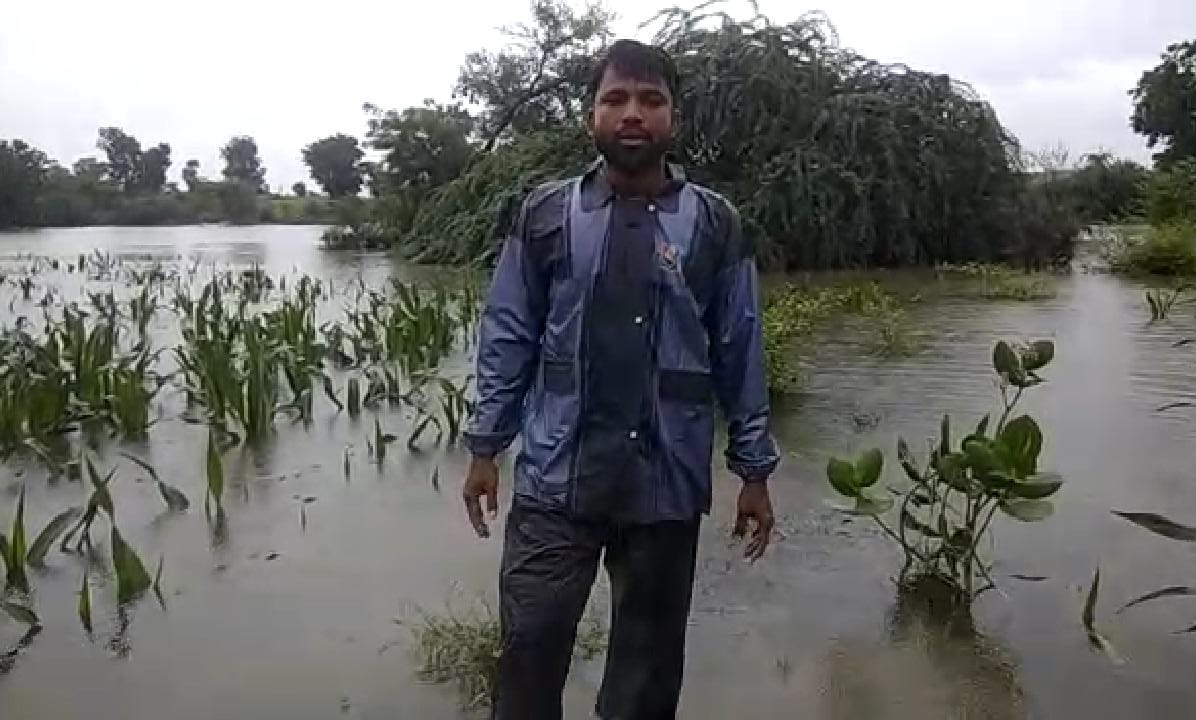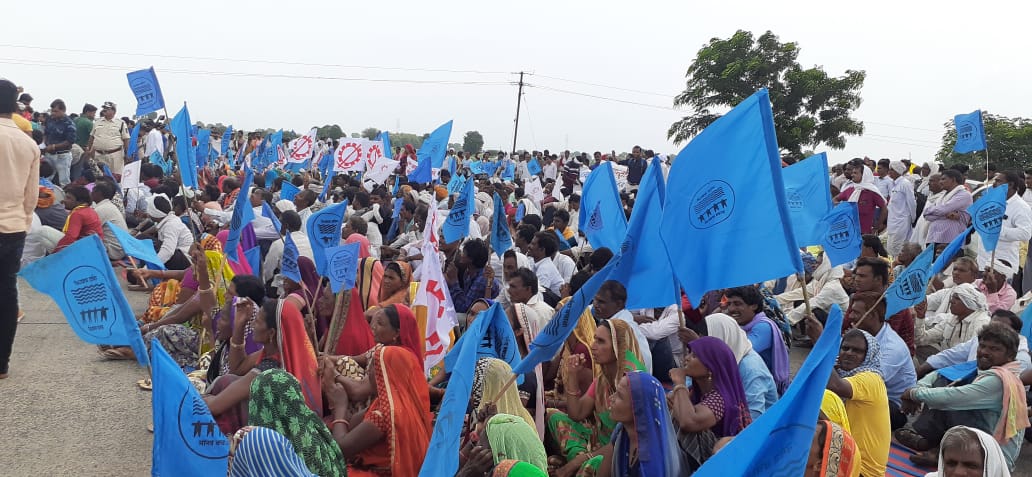Activists demand a restriction in water levels to 122 meters and demand the rehabilitation of 32,000 families

Detailed updates from ground level activists of the Narmada Bachao Andolan (NBA) reveal that the water levels in Sardar Sarovar dam is rising fast owing to the Gujarat government’s decision to fill the reservoir to 138.68 meter over the course of the next 50 days, to the full reservoir level (FRL) of the reservoir. Media reports statethat the government will “regulate” the flows in “such a manner that the water level will rise by 0.30 m every 48 hours.
This year, the situation on the ground, is increasingly reaching an alarming level. On August 12, activists have reported that two people died because of electric shock from the water. They predict large scale destruction over the next few days. Activists with the NBA have demanded that water level rise should be stopped at 122 meters; also that court orders related to the protection and rehabilitation of people living in downstream and upstream (dam) areas should be followed. Today, women and men activists, under the banner of “JeevanRekhaAndolan” have blocked the Agra-Delhi Highway demanding that the government restricts the water levels to 122 meters. There are reports emerging of considerable violence unleashed on the protesters as we go to press.





In a detailed press note issued on Monday, NBA activists have predicted that if the water level keeps increasing at this alarming speed, as many as 32,000 families stand at the risk of facing a “water calamity”.The water level touched an unprecedented limit at 131.50 m on Friday. After this, the government released six lakh cusecs of water into the downstream and the Narmada main canal. Ten gates were opened on Friday, first time ever since independence.
The managing director Rajiv Gupta of the Sardar Sarovar Narmada Nigam Limited (SSNNL) reportedlysaidthat it was “essential to test the dam at full reservoir level” as this had not been done since the gates were installed in 2017.” He added, “The state government will adhere to the norms laid down in the dam safety manual while filling the dam to FRL in the next 50 days.” Notably, in his own words dam hasn’t been “tested at FRL because of deficient rainfall in earlier years.”However, past experience suggests that authorities are usually ill prepared to handle any disasters which may come in the way, especially a flood like situation.
Chief minister Vijay Rupani even performed a “puja” at the dam site on Friday, August 000 to ‘mark’ the 131.50 m ‘milestone’. According to a Times of India report, in Surat at least 2300 families were shifted to safer locations from different areas located on the Narmada River in Bharuch district on Friday
A press release issued by Narmada Bachao Andolan (NBA) on August 12 highlights the gravity of the situation. Activists have claimed that Narmada is flowing at a level of 9 meters above the danger level. And that it has reached the villages which have been impacted by the Sardar Sarovar dam.In the Manavar tehsil, more than 4000 families are settled in 17 villages and haven’t been rehabilitated properly, they claim. In villages such as Kavathi, Uradana, Ekalbara, Gangli etc., the path leading to the farmland has been blocked as water has entered the fields. Activists have claimed that this is a “flood like situation”.
Many of these villages, according to the chief minister’s own reported statements are yet to be compensated upto an amount of Rs. 5,80,000 as per the directives of a Supreme Court order of February 8, 2017.Moreover, the places which were allotted as compensation and rehabilitation remain deprived off basic amenities such as water, electricity, road connectivity etc.
As the tributaries of river Narmada are also filled upto the brim, the situation is quickly escalating at an alarming rate. The NBA has also observed, “If the water level goes beyond 138 meters, then many thousands of families will get submerged without rehabilitation of a house or land.” “In such a situation, where will people go?” it asked.
Further, the press release said,the route to the hamlets located in lower regions of village Ekkalbara are filled with waters from the backwater. The villagers are completely blocked from all sides, and because of this, even for their basic needs, the villagers have to risk their lives in order to get the basic ration etc. One villager named Galsing who went to purchase ration escaped death by a margin. Despite this serious situation, as per the NBA activists, nobody has come to survey or study the area. The village’s approximately 80 percent or 3000 acre land is completely surrounded by water from all sides.
The fields in villages Kavathi and Gangli have been submerged because of Narmada water. Kavathi too, has been turned into an island. A Comptroller and Auditor General of India (CAG) report had highlighted how there were discrepancies in execution of works like granting of tenders and unjustified, higher payments that caused financial losses to the government.
Another very important fact is that most river dams, which may flood if they fail, were not prepared for disaster management. The same CAG report revealed that only 349 dams out of 4862 completed dams in the country have emergency disaster management plans.
To ensure the proper inspection, maintenance and surveillance of existing dams, the Dam Safety Legislation was initiated in 2010. The policy remains on paper, yet to be given the shape of law and enacted, even in August 2016, the CAG report had stated. In most states, pre and post monsoon inspections weren’t carried out. Programmes for maintenance of dams were not prepared and adequate funds were not provided to carry out structural/repair works.
An analytical report published in 2015 had pointed out that one problem faced “by dam operators is that filling the reservoir early in the monsoon may result in excess discharge and floods later on”. In 2015, in the case of Hirakud dam on the river Mahanadi, a large quantum release from its reservoir displaced as many as two million people in 20 of state’s 30 districts. The India Meteorological Department’s (IMD) analysis of the data of the past 100 years says there is no deviation, suggesting a significant change in rainfall patterns. Ajit Tyagi, director general of IMD, however, noted, “But yes, excessive variability and localised events towards end-August and September are forcing release of huge quantum of water from dam reservoirs”.
A DownToEarth report hashighlighted activists’ concerns that the operators sitting in hot spot are often slow in reacting to information on inflow of water and rainfall in the catchment. It also noted the “typical” response by authorities, “there was a sudden influx of water due to incessant rains in the catchment; there is no way to avert these disasters”
There is also much debate around the entrenched belief that building dams actually help in preventing floods. As per Shripad Dharamdhikari, founder of Manthan Adhyayan Kendra, a non-profit that researches water issues, one problem with dams “is that they attenuate lower magnitude floodwater, thereby creating a sense of security. So when the peak floods come, the damage is far greater than otherwise”.
Experts have also predicted that as climate change occurs, flood situations are likely to worsen due to poor management of dams.
A committee constituted by the Ministry of Irrigation in the 1980s to review the existing practices of maintenance of dams in various states and to evolve standard guidelines for the same, said in a report published in 1982, “it is essential to release water as soon as flood-like situations develop.” The report admits that “the existence of a dam upstream of the floodplain may either mitigate the extent of the calamity or accentuate it.” It is essential, therefore, to develop operating rules with built-in factor of safety and adequate and efficient warning system to formulate accurate forecasts on the time lag when rain in the catchment results in increased inflow to the reservoir.”
In 2015, 96 dams in Gujarat were puton high alert following heavy rainfall on the evening of September 11, many of them were full to their capacities, including the Sardar Sarovar Narmada Dam in Kevadia.